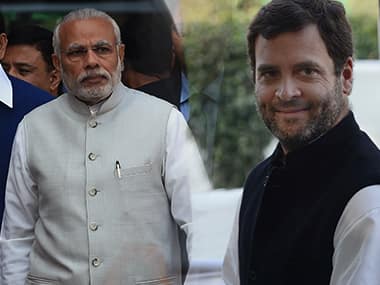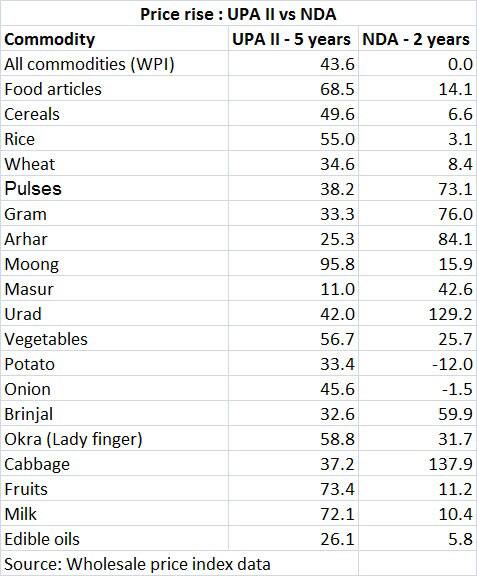Forget his political enemies, there aren’t many even in the Congress camp, who would reckon party vice president Rahul Gandhi, as a mature and level-headed politician. Gandhi is better known for his often impulsive public outbursts and lack of connect with the masses despite many of his stage-managed visits to Uttar Pradesh’s villages. The Congress second-in-command has been on an unending mission to make an image makeover but success still remains elusive for him. [caption id=“attachment_2921144” align=“alignleft” width=“380”]
 Prime Minister Narendra Modi (L) and Congress vice president Rahul Gandhi.[/caption] But, on Monday, speaking in Parliament, Gandhi showed why he isn’t someone to be ignored even by the mighty Narendra Modi. The two crucial issues Gandhi flagged during his speech—the peril of price rise (mainly pulses) and large scale loan write offs during the NDA regime—are something that directly connects with the masses and something the Modi government hasn’t got the solutions right so far. By highlighting these issues, Gandhi has hit the Modi government where it hurts the most. However, on a closer look, one needs to see both these issues in perspective. Let’s look at the price issue first. The NDA government’s two years have been severely hit with deficient rains and severe supply problems. The worst hit was pulses. In these two years, overall, there has been an increase of 73 percent in pulse prices if one goes by the whole sale price index. Of this, the worst has been the prices of Urad dal (up by 120 percent) followed by Arhar dal (84 percent) and gram (76 percent). The Dal price trend is significant in the Indian context since these are traditionally the cheapest protein sources for majority of the Indian households, whether or not they can afford the expensive eggs and milk. The NDA government has, however, managed to check the sharp rise in the from the peak of 58 percent in on-year jump logged in November 2015 to 26.6 percent in the latest reading. Compared to that the UPA 2 regime witnessed the pulses price rise by 38 percent with moong (96 percent), Urad dal (42 percent), gram (33 percent) and Arhar (25 percent) topping the list. As for the vegetable prices are concerned, overall costs went up by 26 percent during the NDA’s two years with certain items such as cabbage (up 138 percent) and brinjal (69 percent) topping the list. Vegetable inflation, in fact, rose by 57 percent. However, overall food inflation, as indicated by the WPI numbers, has actually come down during the NDA’s two year term to 14 percent compared with UPA’s 68 percent. Here Gandhi should expect some counter-questions.
Prime Minister Narendra Modi (L) and Congress vice president Rahul Gandhi.[/caption] But, on Monday, speaking in Parliament, Gandhi showed why he isn’t someone to be ignored even by the mighty Narendra Modi. The two crucial issues Gandhi flagged during his speech—the peril of price rise (mainly pulses) and large scale loan write offs during the NDA regime—are something that directly connects with the masses and something the Modi government hasn’t got the solutions right so far. By highlighting these issues, Gandhi has hit the Modi government where it hurts the most. However, on a closer look, one needs to see both these issues in perspective. Let’s look at the price issue first. The NDA government’s two years have been severely hit with deficient rains and severe supply problems. The worst hit was pulses. In these two years, overall, there has been an increase of 73 percent in pulse prices if one goes by the whole sale price index. Of this, the worst has been the prices of Urad dal (up by 120 percent) followed by Arhar dal (84 percent) and gram (76 percent). The Dal price trend is significant in the Indian context since these are traditionally the cheapest protein sources for majority of the Indian households, whether or not they can afford the expensive eggs and milk. The NDA government has, however, managed to check the sharp rise in the from the peak of 58 percent in on-year jump logged in November 2015 to 26.6 percent in the latest reading. Compared to that the UPA 2 regime witnessed the pulses price rise by 38 percent with moong (96 percent), Urad dal (42 percent), gram (33 percent) and Arhar (25 percent) topping the list. As for the vegetable prices are concerned, overall costs went up by 26 percent during the NDA’s two years with certain items such as cabbage (up 138 percent) and brinjal (69 percent) topping the list. Vegetable inflation, in fact, rose by 57 percent. However, overall food inflation, as indicated by the WPI numbers, has actually come down during the NDA’s two year term to 14 percent compared with UPA’s 68 percent. Here Gandhi should expect some counter-questions.
 But, nevertheless, the fact is that no matter what the inflation numbers show, the price pressures have severely hurt the common man snatching away the fruits of the so-called high growth reflected by the high GDP numbers. This will give Gandhi enough opportunity to instantly connect with the rural masses with his ‘Arhar Modi’ jibe at the Prime Minister. Massive loan write offs Gandhi has again found a critical point when he highlighted the massive corporate loan write offs by public sector banks (PSBs) during the NDA’s term. India’s state-run banks have written of a total of Rs 59,500 crore loans, majority of them corporate debt, in 2015-16 alone. In other words, in just last one year (FY16) of NDA-rule, PSBs have written off more than half of the combined loan amount they did in last three years. Here again, Gandhi is bang on highlighting this issue for the simple reason that every time government banks go for massive loan write offs, it is the common depositors and taxpayers who are taking the real hit. Why? Banks have to take huge provisioning hit when they do this, which severely impacts their profitability. Government banks survive on annual capital infusion from the government. In other words, the taxpayers money is used to bail out these banks. Hence, when these banks write off large chunk of loans, it is the taxpayer which is ultimately taking the hit. In the last nine years, the government has infused Rs 1.18 lakh crore in state-run banks, including the Rs 23,000 crore infused so far this fiscal year. SBI has received the largest pie (Rs 29,000 crore). But this has a flip side too. During the UPA’s second term too, PSBs have been forced to write off huge loans. Remember the 2008-09 farm loan waiver during former finance minister, P Chidambaram’s tenure, when the government forced state-run banks to waive off about Rs 70,000 crore of farmers at one go, thus destroying the credit culture and severely hurting the balance sheets of state-run banks. Though there is an excuse that the government did so to help the distressed farmers hit the by the drought, the fact remains that the Congress-led UPA too played with public money, the benefit of which to the actual marginal farmers are still debatable. When it comes to the misuse and micromanagement of state-run banks and making these lenders vulnerable to the infamous corporate-political nexus, UPA was no better. The short point is this: Rahul Gandhi has certainly used his Parliament time well picking up the right issues to hit the Modi government and to show why he still has the potential to emerge as a dangerous political opponent. Gandhi’s ‘Arhar Modi’ jibe on Modi and the issue of massive corporate loan write offs will certainly connect with the rural electorate. But both these issues are not something which the two UPA governments can claim that ‘we did everything right’. Gandhi shouldn’t forget the past and should be prepared to face questions. (Kishor Kadam contributed to this story.)
But, nevertheless, the fact is that no matter what the inflation numbers show, the price pressures have severely hurt the common man snatching away the fruits of the so-called high growth reflected by the high GDP numbers. This will give Gandhi enough opportunity to instantly connect with the rural masses with his ‘Arhar Modi’ jibe at the Prime Minister. Massive loan write offs Gandhi has again found a critical point when he highlighted the massive corporate loan write offs by public sector banks (PSBs) during the NDA’s term. India’s state-run banks have written of a total of Rs 59,500 crore loans, majority of them corporate debt, in 2015-16 alone. In other words, in just last one year (FY16) of NDA-rule, PSBs have written off more than half of the combined loan amount they did in last three years. Here again, Gandhi is bang on highlighting this issue for the simple reason that every time government banks go for massive loan write offs, it is the common depositors and taxpayers who are taking the real hit. Why? Banks have to take huge provisioning hit when they do this, which severely impacts their profitability. Government banks survive on annual capital infusion from the government. In other words, the taxpayers money is used to bail out these banks. Hence, when these banks write off large chunk of loans, it is the taxpayer which is ultimately taking the hit. In the last nine years, the government has infused Rs 1.18 lakh crore in state-run banks, including the Rs 23,000 crore infused so far this fiscal year. SBI has received the largest pie (Rs 29,000 crore). But this has a flip side too. During the UPA’s second term too, PSBs have been forced to write off huge loans. Remember the 2008-09 farm loan waiver during former finance minister, P Chidambaram’s tenure, when the government forced state-run banks to waive off about Rs 70,000 crore of farmers at one go, thus destroying the credit culture and severely hurting the balance sheets of state-run banks. Though there is an excuse that the government did so to help the distressed farmers hit the by the drought, the fact remains that the Congress-led UPA too played with public money, the benefit of which to the actual marginal farmers are still debatable. When it comes to the misuse and micromanagement of state-run banks and making these lenders vulnerable to the infamous corporate-political nexus, UPA was no better. The short point is this: Rahul Gandhi has certainly used his Parliament time well picking up the right issues to hit the Modi government and to show why he still has the potential to emerge as a dangerous political opponent. Gandhi’s ‘Arhar Modi’ jibe on Modi and the issue of massive corporate loan write offs will certainly connect with the rural electorate. But both these issues are not something which the two UPA governments can claim that ‘we did everything right’. Gandhi shouldn’t forget the past and should be prepared to face questions. (Kishor Kadam contributed to this story.)
Rahul Gandhi picks right ammo to hit Modi govt, but he shouldn't forget the past
Dinesh Unnikrishnan
• July 28, 2016, 21:01:21 IST
The NDA government has, however, managed to check the sharp rise in the from the peak of 58 percent in on-year jump logged in November 2015 to 26.6 percent in the latest reading.
Advertisement
)
End of Article